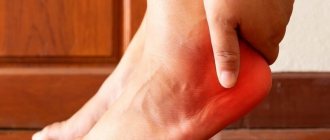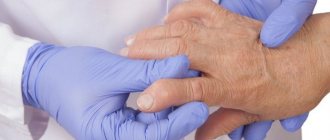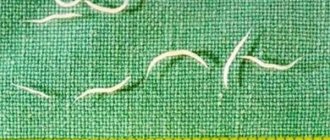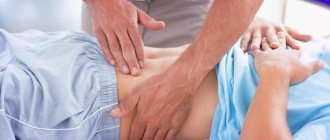Foot pain can be located in any part of the foot, including the toes, heel or Achilles tendon.
In some cases, the pain is minor and goes away on its own. But often, the pain can be intense, especially in the presence of injuries or chronic inflammatory processes. Foot pain is a fairly common complaint among people (up to 75% will experience it during their lifetime). In most cases, foot pain is associated with wearing uncomfortable shoes (narrow, tight or high heels). The leg is a complex structure consisting of 26 bones and 33 joints. And 120 ligaments, nerves and muscles. The function of the foot is to maintain body weight, perform a shock-absorbing function, act as a lever when moving the leg forward, and maintain body balance on uneven surfaces.
Because the foot is relatively small compared to the body, the impact on the foot when walking is very large. Load vectors are 1.5 times body weight. The average person spends 4 hours a day on their feet and takes approximately 8-10,000 steps. That is, the foot can withstand a moving load equivalent to moving several hundred tons during the day.
Causes
There are a large number of provoking factors for foot pain. Discomfort occurs while walking, in a calm state, during changes in the weather, or during long walks. Only a specialist can accurately determine the causes of foot pain and select therapy. However, in order to exclude long-term treatment, you should take care of the condition of the lower extremities and not ignore the initial symptoms of emerging diseases. Foot pain is caused by the following factors:
- Excessive physical activity. According to research, the maximum stress is placed on the spinal column, knee joints and feet during walking, running and under heavy mechanical stress. The more active the patient's lifestyle, the greater the likelihood of developing pain in the middle of the foot.
- Overweight. There is a certain correlation between the patient’s weight and the likelihood of pain. The greater the mass, the higher the chances of difficulties in the musculoskeletal system. This is due to the increased load on the feet.
- Unbalanced diet. Deviations in nutrition, in particular when there is an insufficient amount of calcium and minerals in the menu, often lead to discomfort in the lower extremities.
- Endocrine diseases. Failures in metabolism can cause significant amounts of minerals to leak into the bloodstream. As a result, calcium salts and other minerals are deposited in the structure of the foot.
- Hereditary factor. Genetic disposition sometimes suggests the appearance of pathological processes in the musculoskeletal system.
- Presence of bad habits. Tobacco smoking and excessive consumption of alcoholic beverages lead to decreased elasticity and flexibility of the foot structures. The consequence of this will be dystrophic changes in the legs.
- Passive lifestyle. People who sit in one place are no less at risk than those who are engaged in intense workloads. Due to physical inactivity, stagnation occurs in the musculoskeletal skeleton.
By identifying the triggering factors for foot pain, it is possible to select effective treatment for the disease.
Ways to combat osteoporosis
As you know, osteoporosis occurs due to a lack of calcium in the body. As a result, bones lose their natural strength and become susceptible to excessive stress and injury. This contributes to the development of destructive processes; a person’s feet hurt for no apparent reason, swelling and redness of the lower extremities are observed, and other signs of calcium deficiency also make themselves felt. As a rule, this disease affects men and women over the age of 55 years.
Therapeutic measures prescribed to combat pathology are aimed primarily at eliminating pain. In this case, the emphasis is on the use of analgesics, calcium-containing drugs and bisphosphonates. It is also important to change your diet in favor of taking foods that contain calcium and performing a massage.
The SWT procedure prescribed for osteoporosis deserves special attention. During it, a special apparatus is used that generates sound waves of a certain frequency. The positive effects of the technique include:
- Removal of calcium deposits that accumulate in ligaments;
- Improving blood flow in affected areas;
- Restoring the healthy state of cartilage and bone tissue;
- Spasms and pain that arise in the foot for no particular reason go away;
- Restoration of the body at the cellular level;
- Inflammation is eliminated;
- Swelling decreases;
- Metabolic processes in the muscles located at the site of injury are enhanced.
Diseases that cause foot pain
The causes of pain in the foot are sometimes hidden in a variety of factors; sensations at this moment manifest themselves in different ways. Discomfort in the legs, which appeared as a result of intense exercise, will disappear after 2-3 days. If it remains longer, there is a possibility that the patient has complex pathologies. Such symptoms in some cases indicate a specific disease.
If a person has foot pain, regardless of location, appropriate measures should be taken. Most dangerous diseases begin with difficulty moving and slight discomfort, which will develop into painful sensations. Therefore, to prevent such situations, it is necessary to consult a doctor in a timely manner.
Injuries
Damage is the most obvious factor in foot discomfort. Dislocations, subluxations, and fractures in the bones lead to unpleasant sensations. Pain in the foot area when stepping can be caused by:
- Dislocations of the joints of the feet. In such situations, pain in the foot under the toes will be constant and intensify while walking. A Lisfranc dislocation occurs in the middle of the arch of the foot, where the metatarsal and tarsal bones attach. Dislocation in the area of the Chopart joint is observed in the articulation of the heel and talus. With such damage, it is painful for a person to step on the foot and move. Each condition requires immediate medical attention.
- Ankle injury. It is the most common injury during which pain is felt in the feet. There are situations of chronic dislocations due to weakness of the ligamentous apparatus. Most often, the pathological process occurs in patients who are overweight.
According to statistics, the largest number of pathologies of this profile are bruises (more than 55%). Complete and partial fractures of the heel (up to 5%) and phalangeal bones (up to 10%) are slightly less common. The remaining 1/4 is damage to the ligamentous apparatus: sprains, tears.
Bursitis
Pathology is an inflammatory-degenerative lesion of the synovial bursa and adjacent anatomical structures. Most often, the disease occurs as a result of professional activities. It appears in athletes, loaders, construction workers, etc. Since the disease is concentrated in the tendons, it is sometimes quite difficult to differentiate bursitis from tendonitis without appropriate diagnosis. Characteristic signs of bursitis include:
- Intense pain in the arch of the foot. They concentrate in the heel, spread over the entire foot, and radiate to the area under the toes.
- Swelling in the affected area. They are formed due to inflammatory processes and the release of a significant volume of intercellular fluid.
- Redness of the affected area. Not observed in all cases.
You might be interested - What causes redness on the legs?
In certain situations, the disease is of an infectious-inflammatory nature. In this case, the root cause should be sought in a nearby focus of chronic infectious lesions. Pathogenic microorganisms are transported to the inflammatory focus by lymphogenous and hematogenous methods.
Osteoporosis
In certain situations, the patient does not notice the symptoms for a long time and does not understand why the foot hurts. The pathology is mainly observed in older people. Associated with metabolic disorders. Calcium is washed out in the bones, which enters the bloodstream, settling on soft tissues and causing calcification. This disease increases the fragility of bone tissue several times. Apart from the pain in the bones of the feet, there are no other symptoms. Sudden fractures in the fingers, shins, and heels are possible while supporting the affected limb.
What are the symptoms of a shin bruise and how to treat it? - take note.
Arthrosis of the foot
Arthrosis of the foot - or a “bone” on the big toe - intense stress, wearing uncomfortable shoes, excessive body weight and other reasons cause the destruction of the metatarsal joint. As a result, a “bone” forms on the finger. The initial manifestations of the pathology will be rapid fatigue of the leg, occasionally the top of the foot hurts when moving, (discomfort increases). It is more difficult for the patient to move and stay on his feet for a long time, his gait changes, and pain in the feet manifests itself even in a calm state.
Fasciitis
Fasciitis (heel spur) is an inflammatory process in the aponeurosis of the heel. Due to the progression of the pathology, there is permanent damage to the heel bone. At the preliminary stage, the disease appears only during walking, but as the pain in the upper part of the foot worsens, it is also noted at rest. Discomfort in the form of a burning sensation in the foot mainly increases at the end of the day.
The consequence will be the formation of stable bone calluses, which over time will transform into a sharp spur.
The neoplasm compresses nerve fibers, blood vessels and other structures, provoking intense pain. Characteristic symptoms other than pain include:
- Inability to walk properly. Lameness develops.
- Decreased foot mobility.
- Swelling in the affected area.
If there is pain in the top of the foot due to fasciitis, NSAIDs are used to relieve the discomfort.
Tendinitis and tenosynovitis
Tendonitis is an inflammatory process in the tendon, mainly the Achilles. Tenosynovitis has similar symptoms to tendinitis. Pathologies are characterized by:
- Intense pain in the foot when walking and at rest. Does not play a special role, the patient moves or sits. Unpleasant sensations remain all the time.
- Local swelling in the affected tissue area.
The immediate provoking factor for the appearance of tenosynovitis is often the inappropriate choice of shoes and prolonged physical activity that involves movement.
Arthritis
A pathological process in which small peripheral joints (thumbs, little fingers) are damaged in the area of the sole. It is formed mainly in 2 main forms: gouty and rheumatoid arthritis. A rather dangerous and insidious disease that develops latently over a long period of time. The symptoms of the disease are very pronounced; the person has severe pain on the outside of the foot, and the leg becomes hot to the touch. In addition, characteristic manifestations are:
- Intense pain. Discomfort increases in the evening, at night, with physical stress. During the day, the pain becomes weaker.
- Hyperemia of damaged joints.
- Swelling in the affected area.
- Joints are deformed.
- The mobility of the entire foot is reduced due to concomitant tendon damage.
The disease in question requires immediate treatment due to the fact that it can cause disability.
Neuroma
It is a benign neoplasm in the nervous tissue, which is localized between the fingers. In fact, a neuroma is not considered a growth. This is the so-called hyperplasia in the interdigital nerve endings. The pain in my foot gets worse every day, and swelling appears. Most often, the pathological process is observed in women and is a significant obstacle to wearing heels.
Flat feet
Most do not consider this phenomenon a disease, but only an anatomical deviation in the structure. But after some time, a person is forced to turn to specialists due to the fact that pain develops in the arch of the foot.
A pathognomonic manifestation will be flattening of the foot and the formation of uneven tension on the lower extremities. The load on the foot will be static, and therefore the mechanical load will fall on certain areas of the sole. This will lead to premature wear of the joints. Symptoms of the disease in question:
- Becoming a flat foot.
- Intense pain under the fingers and in the Achilles tendon. They increase with physical activity.
- Convulsive conditions that are caused by excessive muscle tension.
- Excessive fatigue of the lower extremities.
- The disease can be acquired or congenital.
Varicose veins
With the pathological process under consideration, the foot hurts in the middle. Discomfort will increase gradually, starting from the foot and moving to the lower legs (in certain cases, to the thighs). As the disease progresses, the veins above the foot sometimes hurt. If you have varicose veins in your legs, work that involves physical activity is prohibited, since with prolonged stress the discomfort will become unbearable. In addition, with this pathology, the feet freeze at night and after waking up. In the morning, when a person gets out of bed, the feet hurt again.
Gout
With this disease of the kidneys and joints, uric acid accumulates inside the body and metabolic processes are disrupted. Uric acid salts accumulate in the joints and in the dermis, forming “knots”. Such a pathology must be treated.
If a person has gout, there is severe pain on the outside of the foot, and swelling may form. The disease is also characterized by an increase in temperature. Sometimes the joint near the big toe swells and swells, and discomfort in the foot area occurs unexpectedly. In addition, there is a burning and itching sensation in the foot.
Achilles tendonitis
Achilles tendonitis
Causes
Tendinitis is an inflammation of the tendon that occurs for a variety of reasons.
| Illustration | Cause |
| overload (long-term physical exercise, walking unusually long distances) | |
| intense workouts without pre-warming the muscles | |
| wearing uncomfortable shoes or old worn-out shoes from someone else's feet | |
| excess weight | |
| unevenly distributed load on the foot due to abnormalities in its development or incorrect posture |
Symptoms
You can suspect this problem based on the following symptoms:
- stiffness of the foot and pain in it, which manifests itself especially strongly in the morning;
- swelling of the foot that increases with exercise;
- presence of compactions in tissues.
If swelling of the foot increases during exercise, you should suspect the presence of the disease.
You can ignore them if these symptoms pass quickly and do not return. Otherwise, you should see a traumatologist.
Treatment
Tendonitis is easier to treat at the onset of the disease. To do this, it is enough to undergo a course of physical therapy, take anti-inflammatory drugs or injections. In advanced cases and chronic inflammation, it is sometimes necessary to resort to surgical intervention.
Treatment of Achilles tendonitis
Note! Lack of timely treatment can lead to Achilles tendon rupture. In this case, conservative treatment methods are ineffective; the problem is solved by stitching its ends. Moreover, if this is not done on time, the distance between them increases, which will require their lengthening when making a large incision on the foot.
Diagnostics
Diagnostic measures and treatment of the above pathological processes of the musculoskeletal system and musculoskeletal system are mainly carried out by orthopedists. First of all, it is recommended to consult with a surgeon to receive appropriate directions and undergo an initial examination.
During the consultation, the doctor interviews the patient regarding his well-being, finds out the complaints, their duration and nature. Next, the factors that preceded the formation of the disease are identified. It is necessary to find out what diseases the patient suffered during his life. A visual assessment of the condition of the foot and nearby tissues is carried out.
A qualified specialist at this stage can make the correct diagnosis. Other diagnostic measures are aimed at confirming it. Functional tests and palpation of the foot are highlighted as auxiliary measures of the primary study.
Diagnostics also includes:
- X-ray of the foot. A universal measure that helps assess the condition of the lower extremities.
- MRI and CT. The most informative technique. Helps identify the original cause of pain in the feet when walking.
- Arthroscopy. Prescribed to assess the condition of the joints.
In addition, clinical examinations are carried out:
- General analysis of blood and urine (probably an increase in the content of urate salts in the presence of gout).
- Blood test for rheumatoid factor.
- Biochemical analysis of blood from a vein.
Such methods will be sufficient to make an accurate diagnosis.
It hurts to step on your feet and soles of your feet in the morning
It is very often painful to step on the feet when various vascular pathologies appear. The following diseases can manifest themselves this way:
- diabetic angiopathy – the soft tissues of the foot do not receive adequate nutrition, the process of death of nerve endings and narrowing of small blood vessels begins;
- atherosclerosis of blood vessels - when lipid cholesterol plaques appear, arteries and arterioles are blocked, they do not allow sufficient blood to be delivered to the muscles of the arches of the feet, aches, soreness, and pale skin appear;
- varicose veins of the lower extremities - with the disease, an effusion of plasma from stagnant venous blood occurs into the intercellular space, the resulting swelling in the lower leg and ankle compresses the nerve endings and this provokes pain;
- obliterating endarteritis is a specific disease in which small blood vessels collapse and total tissue neurosis begins; at the initial stage it manifests itself in the form of pain when walking, intermittent claudication.
In addition, it is painful to step on the sole of the foot if you have orthopedic problems with foot placement:
- transverse flatfoot;
- longitudinal flatfoot;
- clubfoot;
- hallux valgus or varus deformity of the foot.
All these problems can develop both in early infancy and in adulthood. Therefore, if it hurts to step on your feet in the morning, you should first visit an orthopedic doctor. He will conduct an examination, a series of diagnostic functional tests, perform plantography and make a preliminary diagnosis. And only after this will it be possible to undergo additional examinations and begin effective and safe treatment.
Treatment
When foot pain occurs due to muscle fatigue or emerging pathologies, it is possible to reduce discomfort and stop the disease in the following ways:
- The feet should have enough rest. You should avoid wearing uncomfortable shoes, heels, prolonged walking, particularly on stairs, standing on your feet for long periods of time, etc.
- Warm baths are taken and massages are given. It is possible to get rid of fatigue and pain in the muscles through warm water and massage. It is carried out independently or you need to walk on a massage carpet. Then the feet are raised above the level of the head and they are allowed to rest in this position for half an hour, repeated every day.
- Special gymnastic exercises are done. When the feet are constantly tense, it is necessary to take breaks and carry out special training: rotational movements of the feet on the sides, stepping with the feet, etc.
- They take vitamin complexes and calcium supplements, medications that strengthen blood vessels. Helps counteract osteoporosis, varicose veins and other pathological processes.
- Wear special orthopedic shoes. Properly selected shoes eliminate muscle tension and flat feet in the initial stages. When prolonged exercise is expected, special orthopedic insoles are purchased for everyday shoes.
If foot pain has developed, therapy will be aimed at relieving the root cause. First of all, specialists try to improve the patient’s well-being. Therapy is carried out taking into account the underlying disease.
Drug treatment
Such therapeutic measures involve the use of specialized medications. It is the most gentle therapy that can provide assistance at the initial stage of pathological processes. The most effective medicines include:
- NSAIDs (Ibuprofen, Nurofen, Ketorolac, Nise, etc.). They help stop inflammatory processes.
- Analgesic drugs (Analgin, Baralgin). Eliminate painful sensations.
- Chondroprotectors (Structum). They make it possible to restore cartilage tissue and normalize the condition of joints. In addition, they help protect the anatomical structures of the foot from pathological influences of an endogenous and exogenous nature.
- Warming solutions (Dimexide, etc.).
All medications have a number of contraindications, age restrictions and side effects. In certain situations, a specialist prescribes a course of injections.
Physiotherapeutic procedures
In addition to medications, experts recommend performing physical procedures (shock wave and magnetic resonance therapy). Such measures will increase muscle and nerve tone in the legs, restore their motor activity, eliminate pain, improve blood flow, speed up metabolic processes, relieve swelling and hyperemia of the skin.
Patients are also prescribed mud compresses, massage, laser, x-ray and ultrasound therapy. Such procedures are aimed at relieving the symptoms of the pathological process and preventing adverse consequences and recurrence.
How long does it take for a broken little toe to heal? - read this article.
Exercise therapy
Therapeutic gymnastic exercises are an effective remedy for painful sensations in the feet, which prevent various types of diseases of the musculoskeletal system (flat feet, neuroma, arthritis, gout and others). Specially designed training is aimed at improving blood circulation, stretching muscles and ligaments, which increases the strength and flexibility of the lower legs. Therefore, with pain in the joints, the feet need constant health-improving gymnastic exercises:
- In a vertical position, they rise on their “toes” and stay in this position for 10 seconds. Return to the starting stance.
- Same starting position (stand on your full foot). The fingers of the lower extremities “tear off” from the surface. Hold for 10 seconds and return to the starting position.
- Without changing the position, turn your feet inward for 15 seconds. The training is repeated up to 20 times.
- In a sitting position, while on a chair, one leg is raised (toes pointing upward). 10 rotational movements of the feet are performed. Repeats from the second.
- While on a chair, raise 2 legs parallel to the surface. With effort they pull their socks towards themselves. You need to stay in this position for a few seconds, then lower your lower limbs. The training is repeated 20 times.
Prevention
If your feet often hurt, you need to reconsider your lifestyle and habits. Women are advised to avoid tight shoes and high heels. Sometimes it is necessary to change jobs if it involves increased physical activity or heavy lifting. You need to avoid stress, eat right and take additional vitamin complexes. When any diseases appear, it is necessary to treat them in a timely manner, since any of them can cause complications on the legs.
It is recommended to strengthen the muscles of the foot by performing simple physical exercises. This will help maintain joint mobility and prevent the development of flat feet. Shoes should be comfortable, with low heels. If you are prone to flat feet or other pathologies, you should use orthopedic insoles.
Complications
If there is no appropriate treatment for discomfort in the feet, extremely dangerous consequences are likely to develop, taking into account the pathology:
- Progressive flat feet can cause foot deformity, chronic pain in the lower extremities and spinal column, and scoliosis.
- As a result of varicose veins, thrombosis develops (the venous lumen is blocked by a blood clot), phlebitis (the venous walls become inflamed), or 2 conditions at once.
- If gout is in an advanced stage, kidney stones often form, severe kidney failure and death.
- The progression of diabetic foot provokes the formation of deep ulcerative lesions, tissue death, loss of sensitivity, blockage of blood vessels, and intense discomfort. Often the pathology causes amputation of 1 or 2 limbs.
Find out why a blood clot in the leg is dangerous in this article.
What measures should be taken if ligaments are damaged?
Sprained ligaments are considered a fairly common problem, as they can be caused by daily household injuries and sports activities. This process can be accompanied by multiple ruptures of ligaments and individual fibers. The main danger of the disease is the development of serious inflammatory processes.
In this case, the patient most often asks the following questions: “The foot hurts when walking: how to treat?”, or “The leg hurts in the foot area: what to do?”. He may also be concerned about bruising and swelling in the lower extremities. Often a person notes a feeling of loss of control in the foot and some stiffness during movement.
To relieve acute pain, it is recommended to use an elastic bandage and take non-steroidal anti-inflammatory drugs. Physiotherapeutic methods are also considered effective: ankle massage and warming up. In the event of a ligament rupture, surgery must be performed urgently. The latest technique, shock wave therapy, allows one to avoid surgical treatment for severe injuries. With its help, it is possible to accelerate collagen synthesis, relieve inflammation, eliminate pain and restore the necessary mobility of the ankle joint.
Read more about the treatment of ankle sprains >>
How and when does diabetic foot start?
As a rule, in patients with type 1 diabetes mellitus, the first signs of diabetic foot appear no earlier than 5 years after the onset of the disease. In type 2, changes may already be present at the time of diagnosis of diabetes.
Patients with diabetic disease complain of the presence of a long-term non-healing wound defect (sometimes multiple defects) on the foot (possibly on both limbs). It is important to note that the ulcer forms at the point of greatest stress. Initially, there may only be a dense callus, under which a wound develops. The duration of ulcers can range from several weeks to 2–6 years.
The presence and severity of pain depends on the condition of the peripheral nerve fibers, the level of local ischemia and the severity of the associated infection. So, with a complete loss of sensitivity due to diabetic neuropathy, it is possible to reduce pain down to its absence.
Recommendations for patients
Treatment is effective only when diabetes is stabilized and blood glucose levels are maintained.
To normalize sugar, it is important to adhere to a diet. You need to give up fast carbohydrates and increase your consumption of plant foods. Sugar is replaced with fructose.
Diabetic foot care for diabetes mellitus boils down to:
- Daily moisturizing of the skin of the feet to prevent cracks.
- Wearing shoes with orthopedic insoles. Shoes should have a rigid rigid sole, a centimeter-long soft insole, and a beveled front edge of the heel. It is advisable to choose lace-up shoes to adjust the width when the limbs are swollen. It is not recommended to wear the same shoes. Insoles should be changed every two days, and the shoes themselves should be aired.
- A neat pedicure. It is necessary to cut the nails not at the root, but retreating a couple of millimeters. Complete the procedures by filing.
If you are ill, it is prohibited:
- Walk barefoot even with healed wounds. You need to wear socks and tights made from natural fabrics, selected according to size. They should not put pressure on the limb.
- Walk for a long time in the cold. Cold leads to vasoconstriction and poor nutrition of the limbs.
- Rub and steam your feet, use a heating pad to warm up.
- Cover the sores with a band-aid.
Flow
When the development of diabetic foot begins, diet and control of sugar levels, proper foot care, periodic examination of the feet and timely monitoring by a doctor are extremely important. In this case, complications rarely develop. In European countries where podiatry services are developed, the development of diabetic gangrene is very rare. The number of amputations due to diabetes in Europe has decreased tenfold, but in Russia diabetic gangrene is the main cause of high amputation rates.









